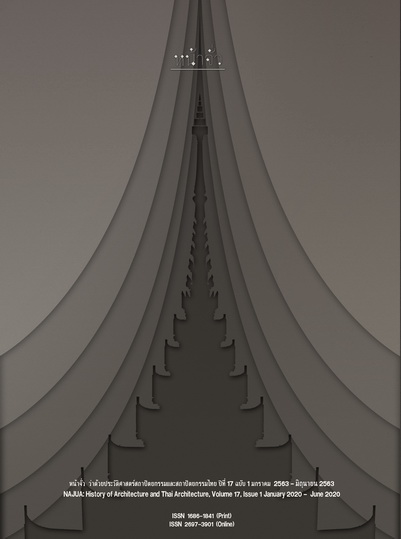Integrated Cultural Landscape Conceptual Plan with Community Network Participation on a Case Study of Chang Moi Area, Chiang Mai Province
Main Article Content
Abstract
This research is an architectural study on urban community which focuses on creating community participation. As an area of study, Chang Moi community is located on an eastern area between Chiang Mai old city and earthen walls along Maekha canal. Since Chiang Mai city has been developed into a regional business centre according to National economic and social development plan in 1961, these old landscapes have been abandoned. The development of Chang Moi community is currently concerned merely on aspects of economics without maintaining local communities. This paper suggests that to develop Chang Moi towards a sustainable city, community participation in city planning is a necessary step to create a corporate image of the city by integrating potential cultural landscape with social relations in this area.
This article is an urban design application to integrate cultural landscape conceptual planning with community participation. The research methodology consists of 3 essential topics on field studies: Existing Community network, Common Cultural landscape, and Community participation. To connect various community networks and qualify cultural landscape inclusively, researcher drove community engagement with two workshops. The first workshop is to set up an active community network and create a corporate image of this district. The second workshop is to design conceptual planning on the site with local community and government agency. As an outcome of the study, this research aims to set up community network sustainably, which engages with local people, business owners, government agency and also relative organizations. Besides, this cultural landscape conceptual planning is a sample of the creative process in urban design following to become a district for Cultural tourism.
Downloads
Article Details

This work is licensed under a Creative Commons Attribution-NonCommercial-NoDerivatives 4.0 International License.
References
Chiranthanin Kitika and Katsuhiko Suzuki. “Integrated neighbourhood network on a case study of condominium community: Nimmanhaemin District, Chiang Mai, Thailand.” International Review for Spatial Planning and Sustainable Development Journal (IRSPSD) 4, 1 (2016): 106-122.
Office of the Prime Minister, “Master Plan under the National Strategy (2018-2037),” 2019.
Orathai Pratad. “kānmī sūanrūam khō̜ng prachāchon nai kānphatthanā chumchon nai phư̄nthī ko̜ Rattanakōsin kō̜ranī sưksā chumchon pō̜m mahākān [Participation of citizens in community development in fort Mahakan, Rattanakosin Island, Thailand].” Master thesis, Faculty of Political Science, Thammasat University, 2015.
Pannita Mitrpakdee. “Creative Economy in Action.” Creative Thailand Magazine 9, 12 (September 2018): 14-15.
Sant Suwatcharapinun. “Reflection of modernity: Re-exploring the role of modern architecture in Chiang Mai (1884-1975).” JARS Journal of Architectural Planning, Research and Studies 12, 1 (September-October 2015): 78-102.
Walanrak Poomchalit and Katsuhiko Suzuki. “A study of the importance of personal interests concerning on urban planning: Case studies in Kyoto City.” JARS Journal of Architectural Planning, Research and Studies 12, 1 (September-October 2015): 17-34.
Interviews
Jirawat Navajak. Social entrepreneur from the ‘Wakebake Skate Café’ in Chiang Moi District. Interview, August 23, 2019.
Kanatsanun Tantananan. Social entrepreneur from the ‘Localist’ creative handicraft shop in Chiang Moi District. Interview, August 23, 2019.
Saowakon Sribunruang. Coordinator from Rak Chiang Mai Community Network. Interview, August 23, 2019.
Tanawitta Vichitaporn. Community Architect from Jaibaan studio. Interview, August 23, 2019.
Wimonisiri Leuakoson. Ming Muang Market organizer. Interview, August 23, 2019.


